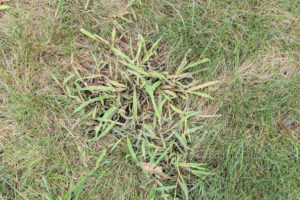
Water Your Lawn
For your grass to grow thick and healthy (and naturally defend itself against weeds) it needs water. But it’s possible your lawn may not be receiving enough. Your lawn should be getting approximately one to two inches of water each week. If it’s not raining enough to cover that, be sure to irrigate your lawn to keep it thick enough to discourage weeds from growing. We recommend giving your lawn a good soaking once or twice a week rather than a little bit every day.
Have a Thick Lawn
Having a thinned-out lawn not only looks unappealing, but it’s also a weed magnet. That’s because weeds thrive in thin and bare spots on your lawn where they don’t have to compete with healthy turf for the sunlight they need to grow. When your grassroots are healthy, there is not much empty space left in the soil for weeds to take root.
Mow Correctly
You might be surprised to know that your mowing habits can also have an impact on your struggle to get rid of weeds in the lawn. When you mow your grass too short or you scalp the edges along your walkways and driveway, you are creating conditions that may be favorable for weed growth. Let grass grow long enough to create shade at ground level and keep moisture in the soil. We recommend you only cut 1/3 of the grass blade each time you mow to prevent stress.
Aerate Your Soil
Crabgrass thrives in compacted soil. Weeds tend to grow close to the surface unlike the deep roots needed for grass. So compacted soil only allows for these invasive plants to thrive. If you can’t seem to get rid of weeds in the lawn, solving your compaction problem may actually help your lawn to become thicker, resulting in fewer weeds. Fortunately, this is something that aeration can remedy by loosening up the soil and allowing more oxygen, water, and nutrients to penetrate below the surface where grassroots truly need them.
Have the Right pH Level
Ideal pH should be between 6.5-7.0, slightly acidic. Generally, lime is added to raise the pH, and sulfur is added to lower the pH, and adding compost can naturally correct your pH. Fertilizer and lime do not kill the crabgrass but instead creates an environment that is more favorable to desirable grass.
We Provide Lawn Fertilization and Weed Control Services
Green & Grow’s Fertilization and Weed Control programs provide a lush, healthy, green lawn. Our lawn fertilization program supplements the soils and feeds the plants. We take weed control very seriously and provide a wide range of treatments to tackle all the common weeds of Central Kentucky. We use only the finest fertilizers to achieve the best results for your lawn.
> Learn More
Contact us (859-314-LAWN) for more information or a free instant quote!
—
 About Green & Grow
About Green & Grow
Green & Grow is a full service lawn care company specializing in lawn mowing, fertilization & weed control, aeration & seeding, insect control, and more!
> Learn More

 About Green & Grow
About Green & Grow